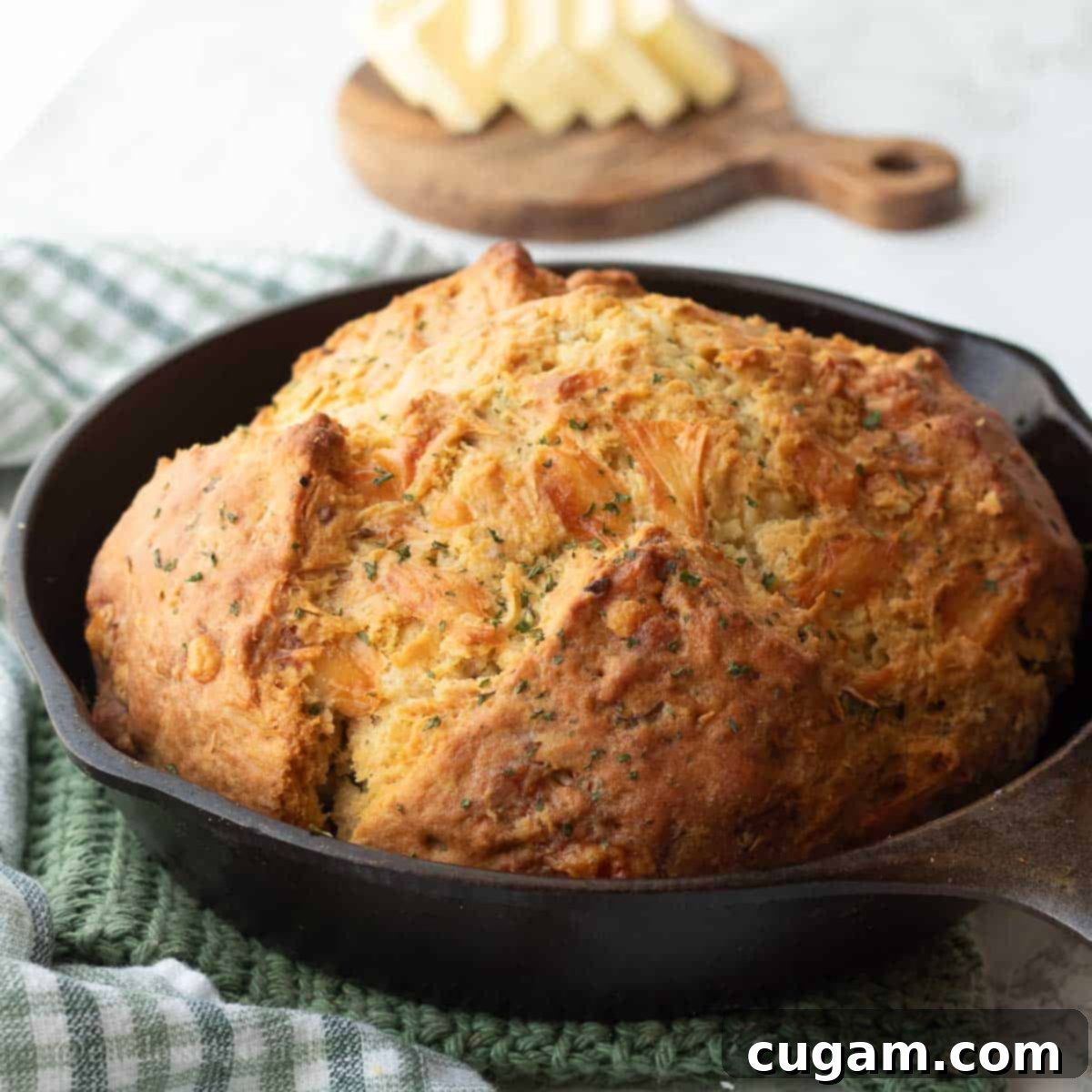Delicious & Easy Savory Irish Cheddar Soda Bread (No Buttermilk Needed!)
Prepare to be delighted by this incredibly savory, easy-to-make Irish cheddar soda bread, infused with aromatic garlic, sweet onions, and an abundance of rich, melty cheese! This quick bread is famously buttery, offering a moist interior and a delightfully crusty exterior. It’s absolutely divine when served warm, straight from the oven, or toasted to perfection with a smear of butter.
We embarked on a flavorful journey, experimenting with various cheeses to find the ultimate pairing for this recipe. While traditional Irish cheeses like Kerrygold Dubliner offered a pleasant, sharp note, our absolute favorite for everyday enjoyment and broad appeal proved to be a good quality medium or sharp cheddar cheese. Its robust flavor melts beautifully, creating pockets of creamy goodness throughout the loaf. This versatile bread is the perfect accompaniment to a hearty bowl of soup, a comforting Crock Pot Beef Stew, or even alongside creamy Red Skin Mashed Potatoes. For a simple treat, it’s unbeatable toasted and slathered with butter.
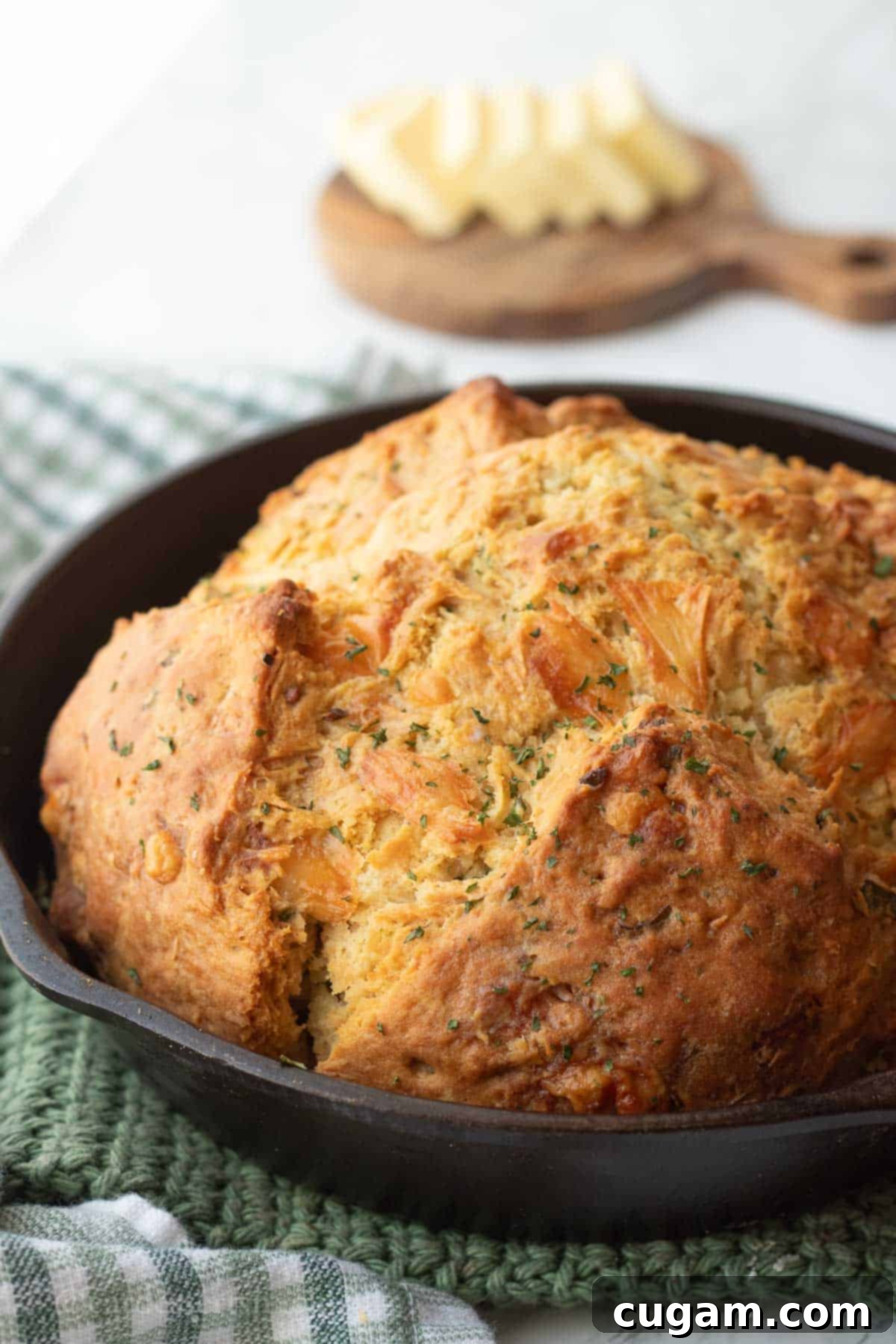
One of the most appealing aspects of this recipe is that it’s a no-yeast bread, often referred to as a “quick bread.” This means you can have a warm, homemade loaf on your table in under an hour, without the lengthy proofing times associated with traditional yeast breads. Our recipe for Irish soda bread without buttermilk utilizes a clever and effective substitute: a simple mixture of milk and vinegar. This acidic component is crucial for activating the baking soda, which then creates the gas bubbles needed to make the bread wonderfully light and fluffy. It’s a fantastic alternative that ensures consistent results every time.
This savory Irish soda bread is not just a delicious side dish; it makes for an excellent snack any time of year, especially for celebrations like St. Patrick’s Day. Its ease of preparation means you can quickly mix and bake a loaf, and trust us, it will disappear just as fast! While we adore a sweet indulgence such as Pistachio Bars for festive occasions, this savory bread offers a perfect balance when served with other Irish-inspired dishes like Irish Poutine with Bacon. It truly is a crowd-pleaser that fits into any meal plan.
Traditionally, Irish soda bread was a staple for many households, a simple and economical way to produce fresh bread quickly. Our savory version takes this classic to a new level with added flavors that elevate it from a basic accompaniment to a standalone star. Whether you’re making it for a holiday, a weekend brunch, or simply to enjoy with your dinner, this recipe delivers on flavor, ease, and satisfaction.
[feast_advanced_jump_to]
What To Expect From This Savory Soda Bread
- Taste: Prepare your palate for a delightful medley of flavors. The prominent notes are the rich, sharp cheddar cheese, complemented by the pungent warmth of garlic and the subtle sweetness of green onions. The bread itself has a lovely, slightly tangy undertone from the milk-vinegar mixture, and a comforting saltiness that balances all the savory elements. Its texture is reminiscent of a tender drop biscuit, but in a more substantial bread form, perfect for tearing and dipping.
- Ease: This recipe is a dream for both novice and experienced bakers alike. The process is incredibly straightforward: you’ll start by incorporating butter into the dry ingredients, then fold in the flavorful cheese and onions before adding the wet components. There’s no complex kneading, no waiting for yeast to rise, and best of all, no mixer required. Everything comes together effortlessly in one bowl, making cleanup a breeze.
- Time: Efficiency is key with this Irish soda bread. The hands-on prep time for mixing the simple dough is surprisingly quick, taking less than 10 minutes. Once assembled, the loaf bakes in approximately 45-50 minutes, meaning you can go from craving homemade bread to enjoying a warm slice in just under an hour. It’s the ideal solution for when you need a delicious bread with minimal fuss and maximum flavor.
🛒 Key Ingredients for Your Savory Irish Soda Bread
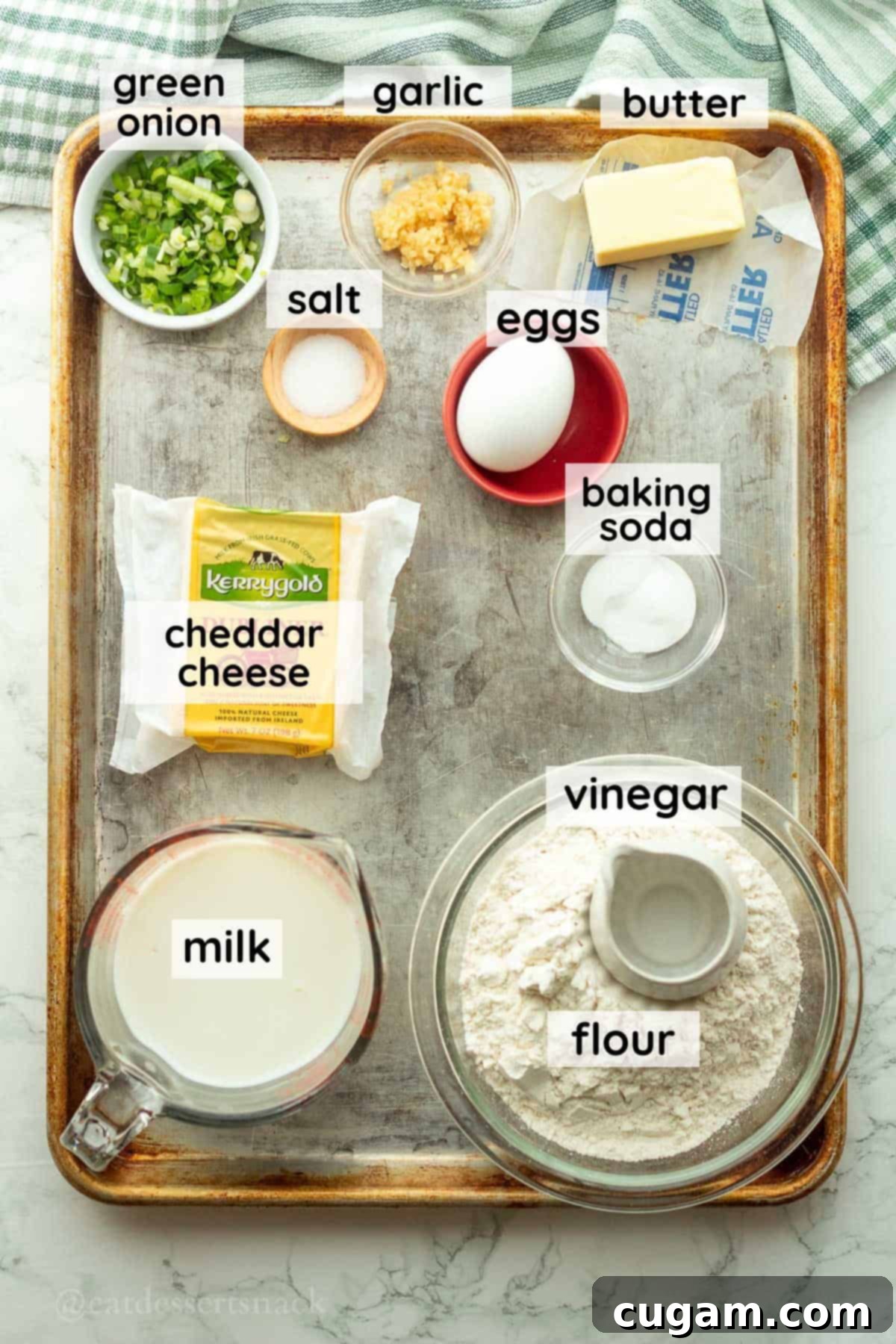
- Cheddar Cheese – The heart of this savory bread! We highly recommend using your favorite medium or sharp cheddar. During our taste tests, a good regular cheddar consistently ranked as #1 for its balanced flavor and excellent melt. While we did try other Irish cheese brands like Kerrygold (including their Dubliner Irish Cheese and Irish Reserve cheddar), we found them to have a stronger, sharper taste that some might find overpowering or too intense, especially for those with sensitive palates or picky eaters. If you love a bold, sharp cheese, these are great options, but for a universally loved and classic flavor, stick with a reliable cheddar. You can chop the cheese into small ¼ inch cubes for delightful pockets of melted cheese, or use large grated pieces to ensure it doesn’t disappear into the dough.
- Garlic – Freshly minced garlic adds an indispensable layer of savory depth to this bread. We use minced garlic for its potent, fresh flavor. However, if fresh garlic isn’t available or you’re short on time, garlic powder works perfectly well as a substitute. Just remember to use half the amount specified for fresh garlic to avoid overpowering the other flavors.
- Green Onion – Essential for both a subtle onion flavor and a touch of color that makes the bread visually appealing. Green onions, also known as scallions, offer a milder, fresher onion taste compared to their larger counterparts. Their delicate flavor beautifully complements the richness of the cheese and garlic, without being too strong.
- **All-Purpose Flour:** The structural base of our quick bread. Ensure it’s fresh for optimal results.
- **Baking Soda:** The key leavening agent. When combined with an acid (like the vinegar in our milk substitute), it creates carbon dioxide, which makes the bread rise and become light.
- **Salt:** Enhances all the flavors in the bread, preventing it from tasting bland.
- **Salted Butter:** Adds incredible richness and a tender crumb. Using cold butter, crumbled into the flour, helps create flaky layers as it melts during baking.
- **Milk & Vinegar:** Our secret weapon for a buttermilk substitute. The vinegar curdles the milk slightly, creating the necessary acid to react with the baking soda. You can use any regular dairy milk, from whole to skim.
- **Egg:** Provides moisture, richness, and acts as a binder, helping to hold the dough together and contribute to a softer texture.
For precise measurements and quantities, please refer to the comprehensive recipe card located below.
✏️ Simple Substitutions & Flavorful Variations
This Irish cheddar soda bread recipe is wonderfully adaptable, allowing you to easily adjust ingredients based on what you have on hand or to explore new flavor combinations. Don’t hesitate to get creative!
- Onion Varieties: While green onions provide a mild and fresh flavor, you have several excellent alternatives. Chives can be used for an even more delicate, oniony herbaceous note. Shallots offer a slightly sweeter, milder onion flavor than regular onions, making them a sophisticated choice. For a more pronounced onion presence, you can finely mince a small amount of yellow or white sweet onion. Just be sure to mince them very finely so they cook evenly within the bread.
- Dairy-Free Options: If you’re looking to make a dairy-free Irish soda bread, several simple swaps will do the trick. The butter can be replaced with an equal amount of solid coconut oil (ensure it’s refined if you don’t want a coconut flavor) or a vegetable shortening. For the milk, any plant-based milk such as almond milk, soy milk, or oat milk can be used in place of whole milk. The vinegar will still react with these non-dairy milks to create a similar acidic environment for the baking soda.
- Tangy Additions: For an extra layer of tanginess and moisture, you could replace half of the milk in the recipe with either plain Greek yogurt or sour cream. Both will contribute a rich texture and a slight tartness that complements the savory flavors beautifully. Just ensure they are full-fat for the best results in terms of texture and richness.
- Herb & Spice Infusions: Elevate the flavor profile further by adding fresh or dried herbs. A tablespoon of finely chopped fresh rosemary or thyme would be wonderful. A pinch of black pepper, a touch of smoked paprika, or a dash of cayenne pepper could add a subtle warmth or kick.
- Other Savory Mix-Ins: Beyond cheese and onions, consider incorporating other savory elements. Crispy, cooked and crumbled bacon bits would be a fantastic addition, enhancing the smoky, salty notes. Finely chopped sun-dried tomatoes (drained well) can add a burst of umami and sweetness. For those who enjoy a bit of heat, a finely minced fresh or pickled jalapeño would offer a delightful zing.
- Different Cheeses: While cheddar is our top pick, feel free to experiment with other cheeses. Gruyere, Parmesan, or even a robust Swiss cheese could offer unique and delicious variations to this versatile bread.
🧑🍳 Step-by-Step Instructions to Master Irish Soda Bread
Making Irish soda bread is surprisingly straightforward, and this recipe is designed for ease and delicious results. While we love the added garlic, onions, and cheese, you can easily omit these for a really good basic Irish soda bread recipe, or customize it with your favorite mix-ins.
Before you begin, don’t forget a crucial first step: preheat your oven to 375℉ (190°C)! This ensures your oven is at the correct temperature for even baking from the moment your bread goes in. You have options for baking: either a 9-inch cast iron pan, which yields a beautifully rustic crust, or a standard baking sheet prepared with parchment paper for easy cleanup and consistent results.
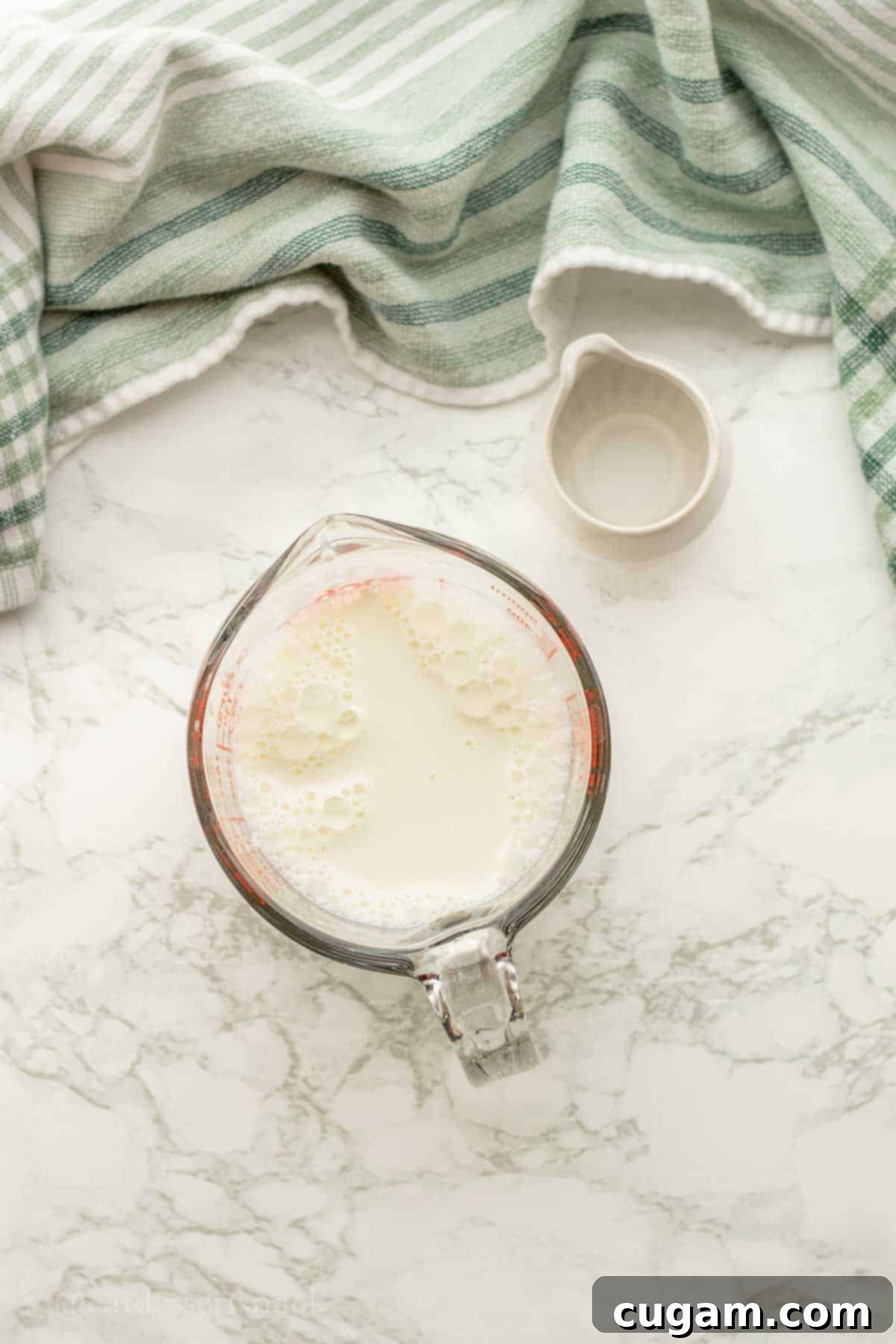
- Step 1. Prepare your “buttermilk” substitute. In a small bowl or a liquid measuring cup, combine the milk and vinegar. Give it a quick stir, then let it sit undisturbed for about 5 minutes. This brief resting period allows the vinegar to slightly curdle the milk, creating the essential acidic environment needed to activate the baking soda and give your bread its rise.
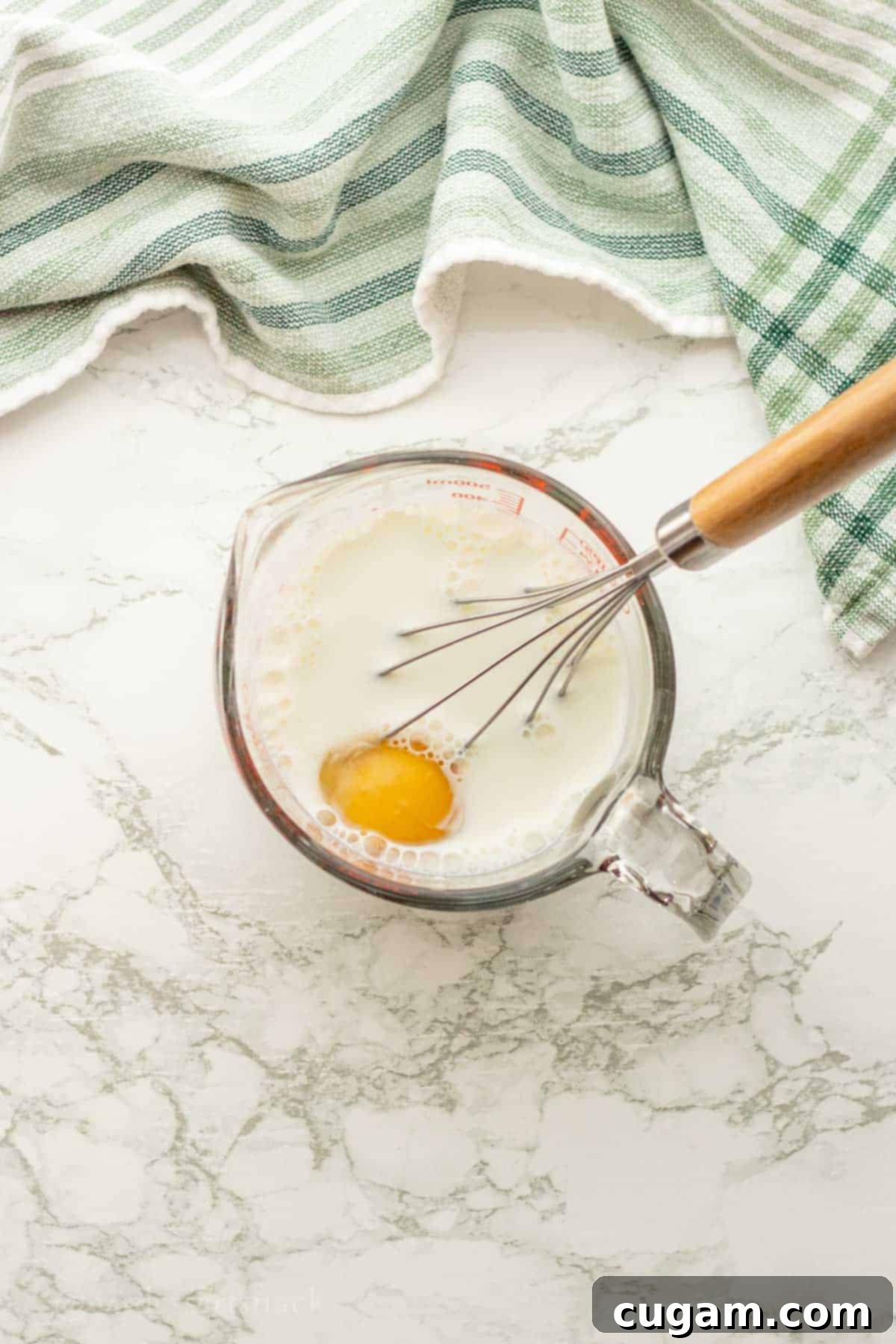
- Step 2. Whisk in the egg. After the milk and vinegar have had a moment to react, crack the egg into this mixture. Whisk everything together thoroughly until the egg is fully incorporated. The egg adds richness, moisture, and acts as a binder, contributing to a softer, more cohesive dough.
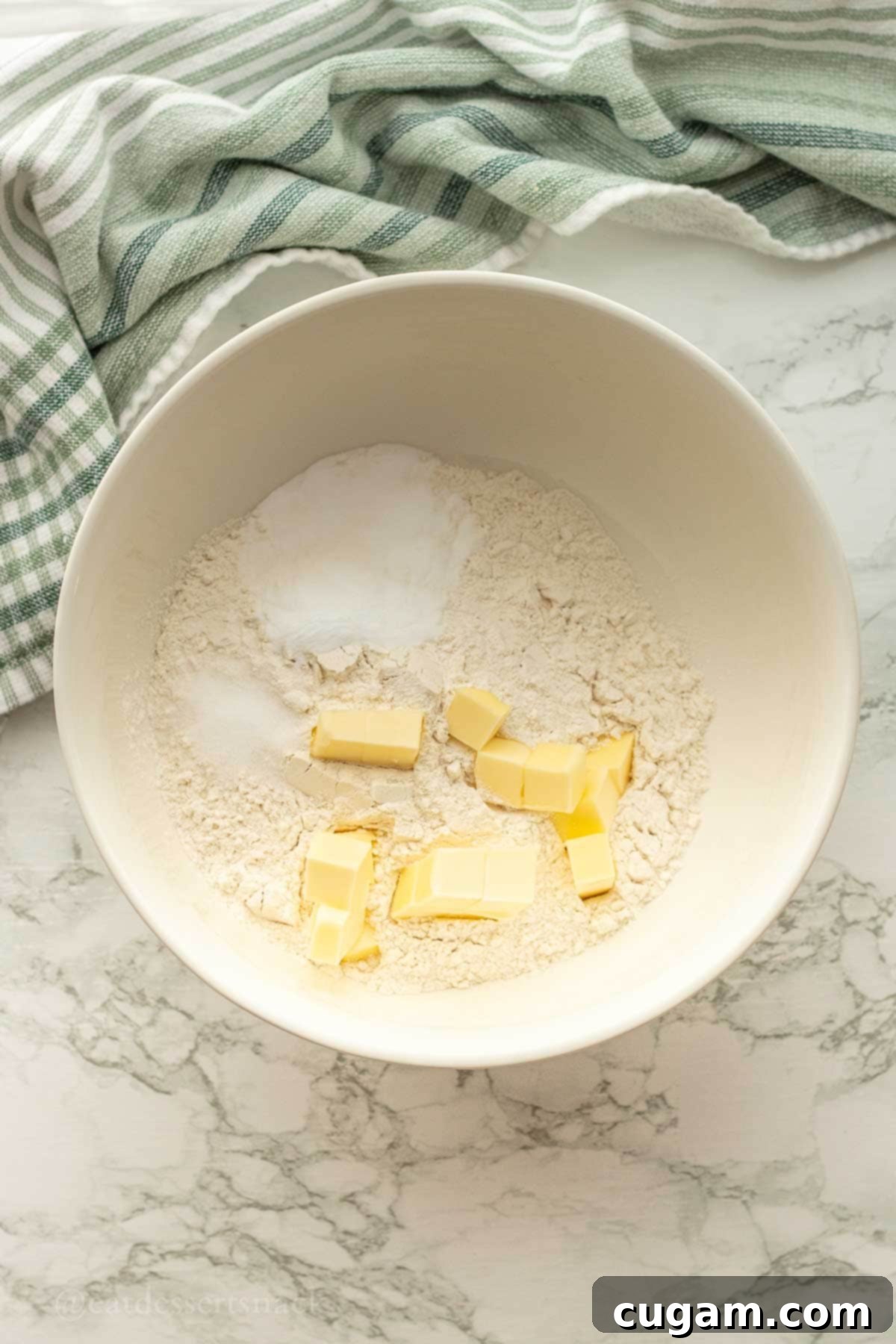
- Step 3. Combine dry ingredients and butter. In a large mixing bowl, measure out your all-purpose flour, baking soda, and salt. Add the cold, cubed butter to this dry mixture. Using your fingertips or a pastry blender (or even a fork), work the butter into the flour until the mixture resembles coarse crumbs, with some pieces of butter still visible, roughly the size of small peas. This technique ensures a tender and flaky texture in the finished bread.
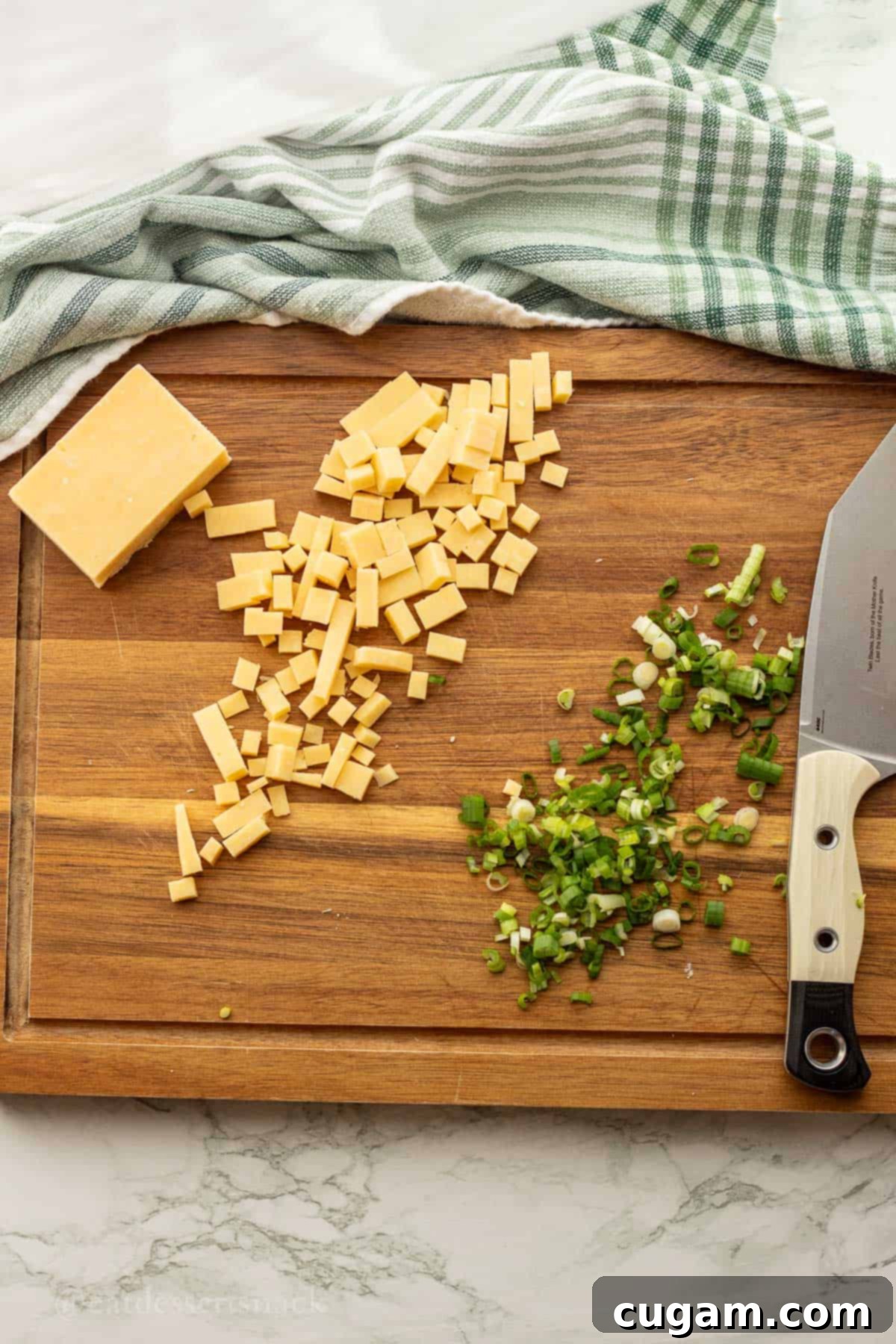
- Step 4. Prepare your savory additions. Finely mince the green onions and chop your cheddar cheese into small, uniform pieces, about ¼ inch (approximately 0.5 cm) cubes. Uniformity in size helps ensure even distribution and melting throughout the bread. The smaller the pieces, the more evenly the flavor will spread.
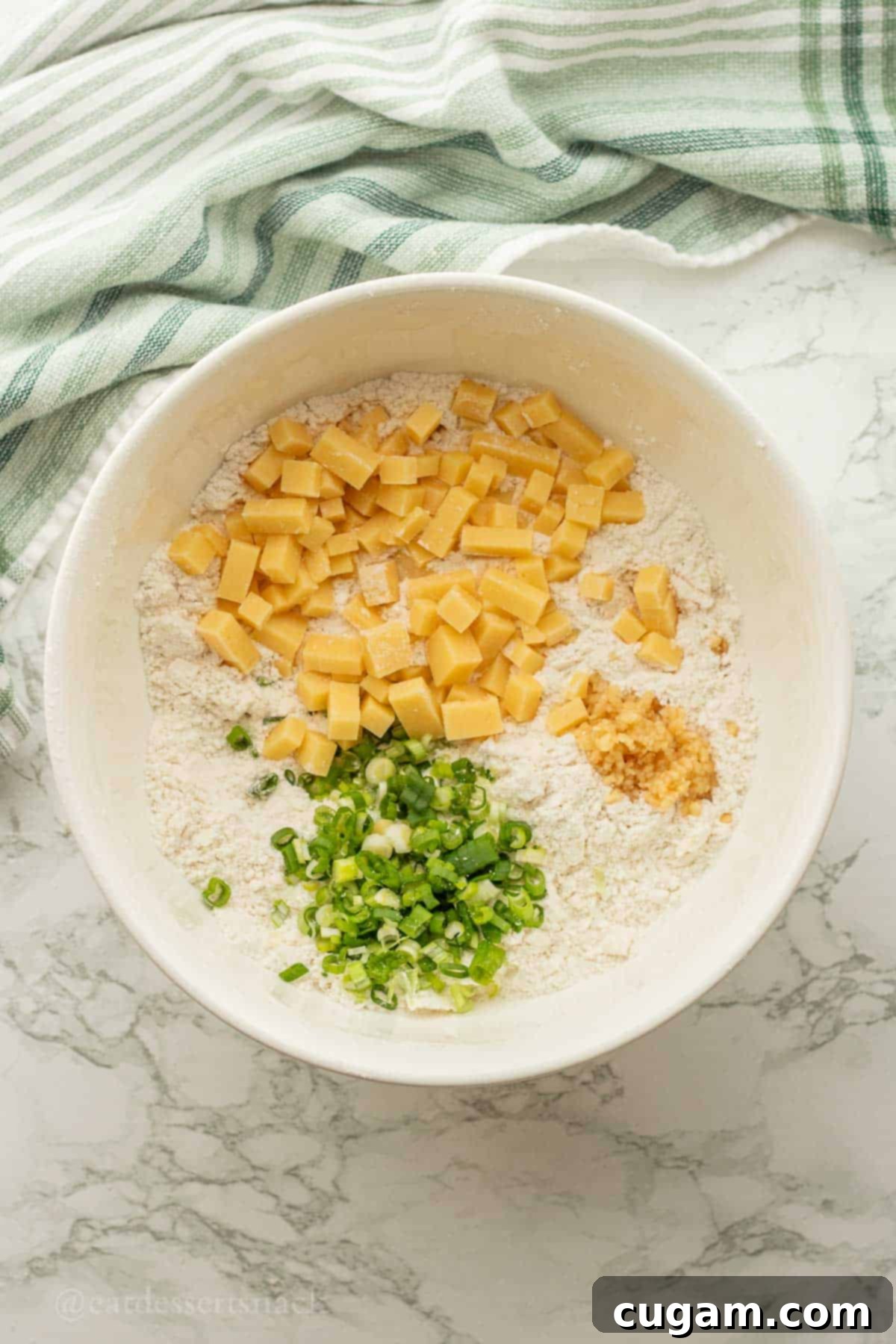
- Step 5. Fold in the flavor. Add the prepared green onions, chopped cheddar cheese, and minced garlic to the flour and butter mixture. Toss gently with your hands or a spoon to ensure they are evenly distributed throughout the dry ingredients. This step ensures that every bite of your soda bread is packed with savory goodness.
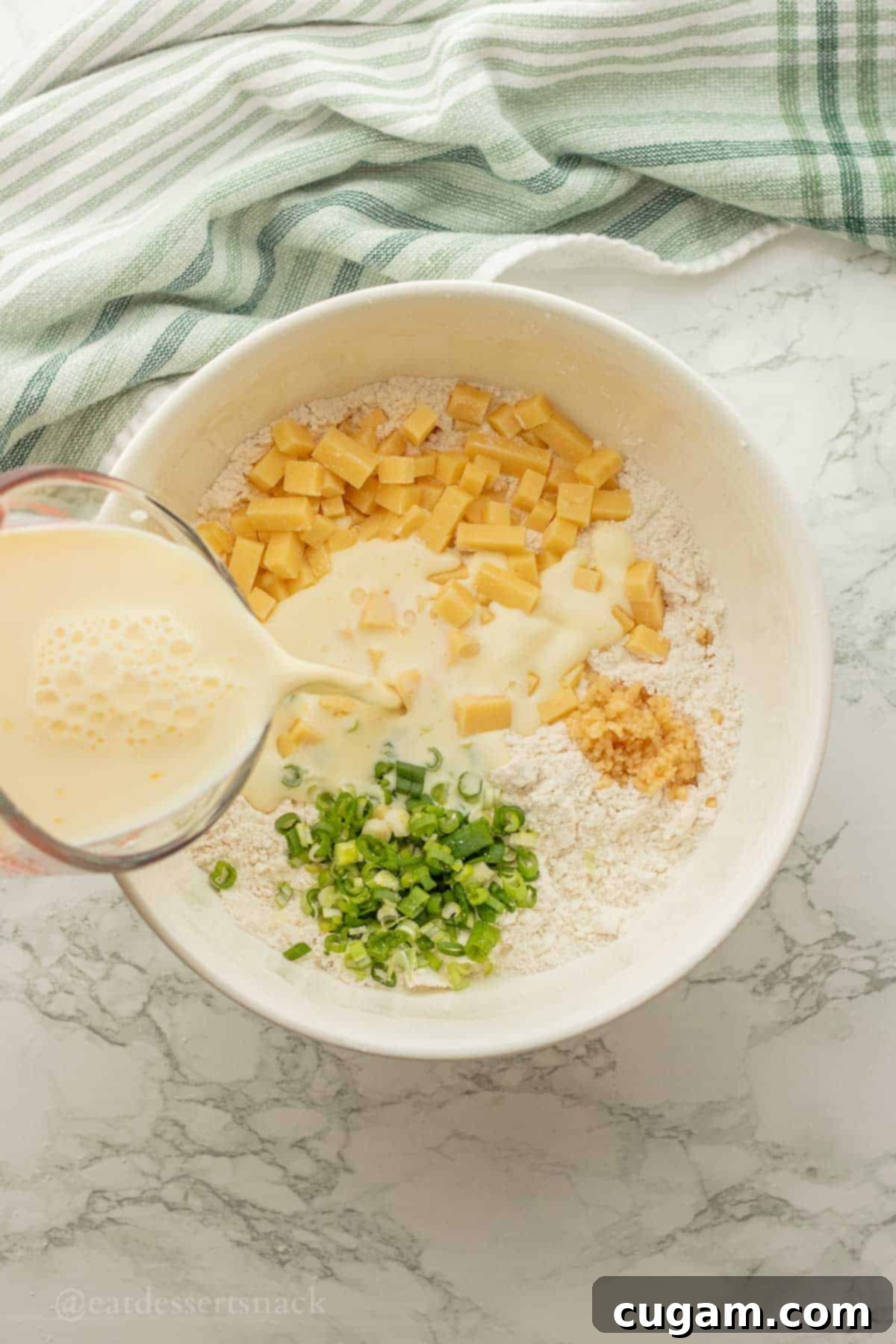
- Step 6. Bring the dough together. Pour the whisked milk and egg mixture into the bowl with the dry ingredients. Using a wooden spoon or your hands, mix until just combined. Be careful not to overmix; overmixing can develop the gluten too much, leading to a tough bread. A few dry streaks are fine at this stage, as they will disappear during gentle kneading.
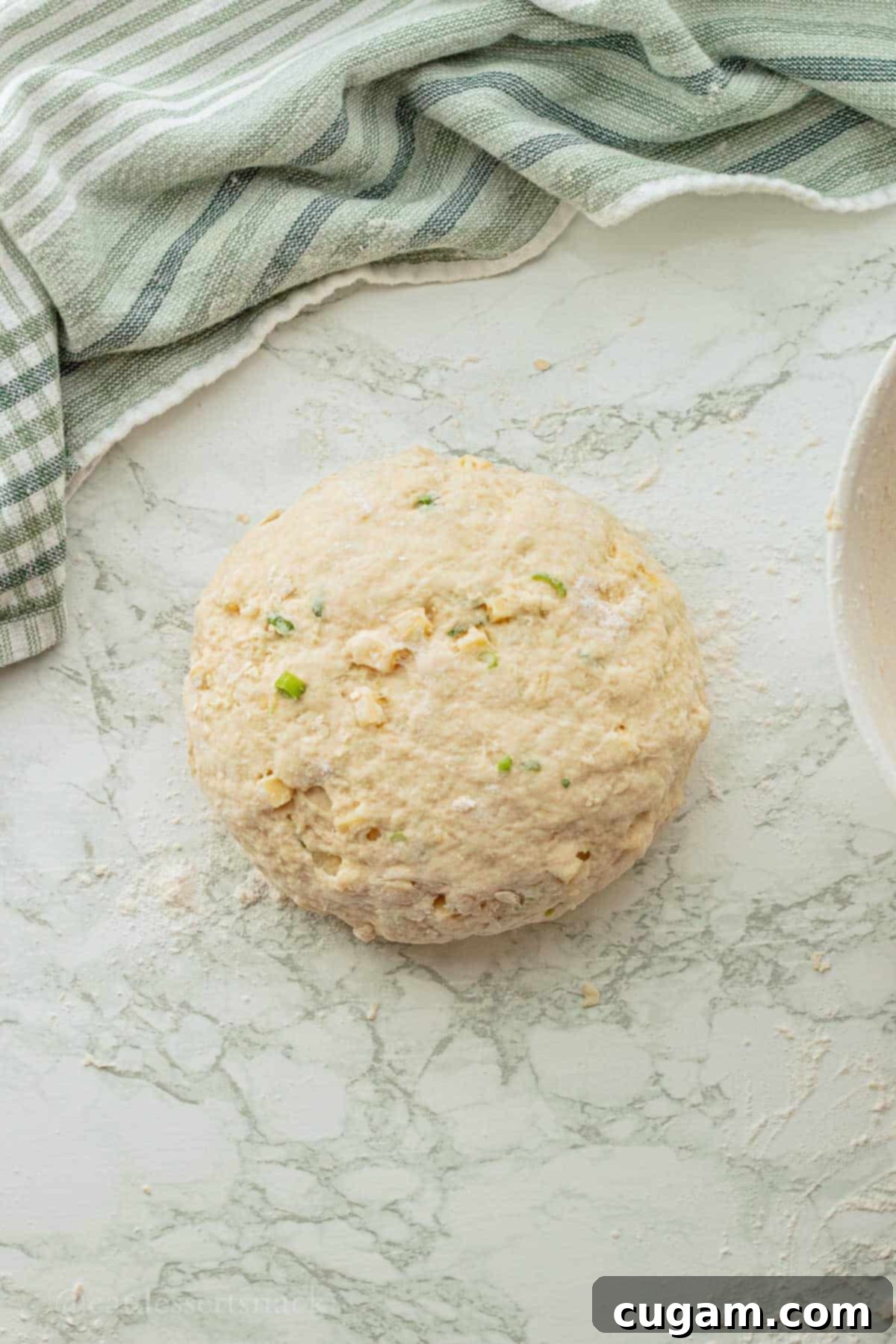
- Step 7. Gently knead and shape. Turn the shaggy dough out onto a lightly floured surface. Knead it gently about 10 times. The goal is just to bring the dough together and ensure there are no remaining dry pockets of flour, not to develop gluten extensively. Lightly dust your hands with extra flour if the dough is a bit sticky. Once cohesive, gently form the dough into a round ball.
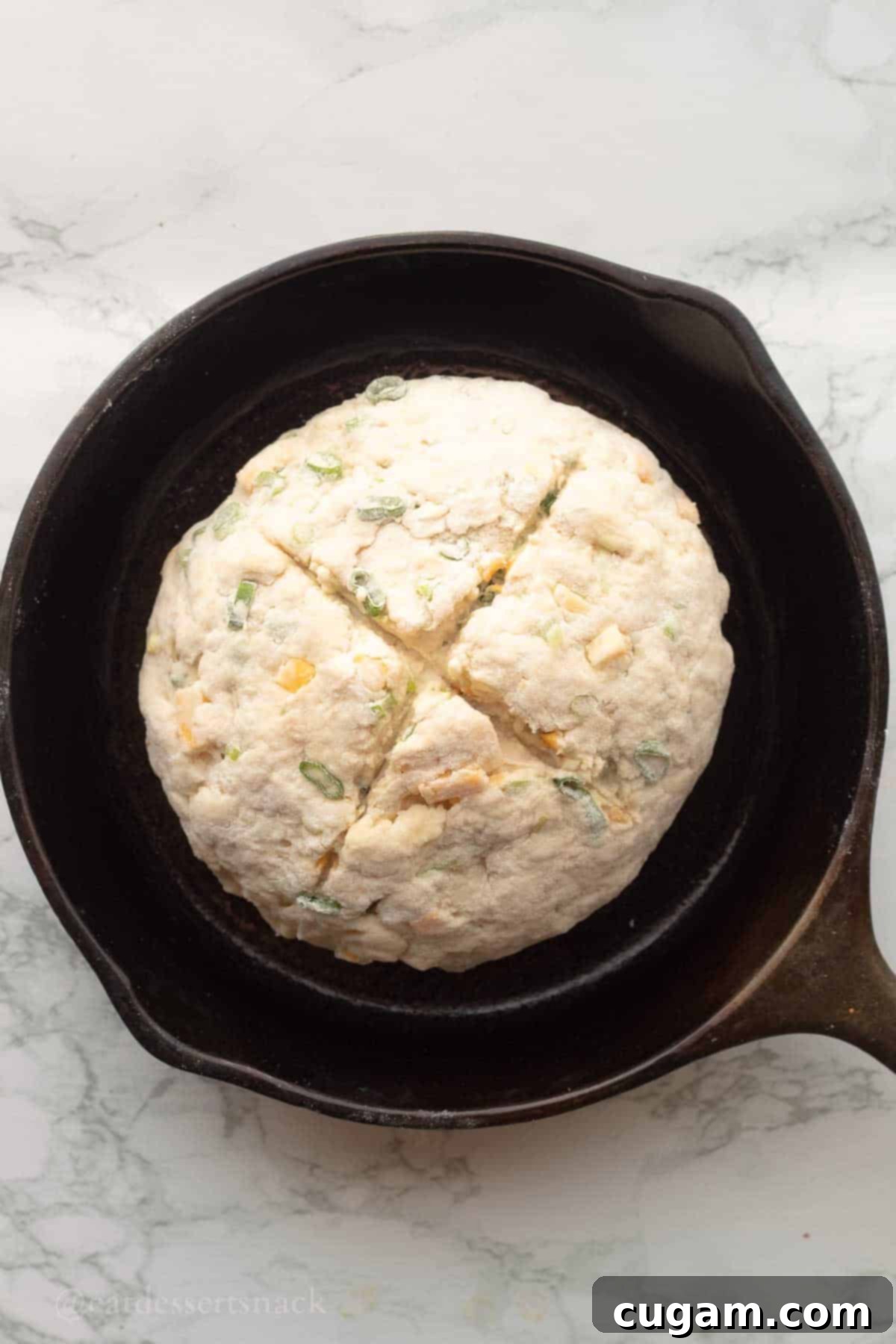
- Step 8. Score and bake. Carefully transfer the dough ball into your prepared cast iron frying pan or onto the parchment-lined baking sheet. Using a sharp knife, cut a cross about ¼ inch (0.5 cm) deep into the top of the loaf. This traditional scoring technique not only adds a rustic charm but also helps the heat penetrate the center of the bread, promoting more even baking.
- Bake the bread in your preheated oven for 45-55 minutes. You’ll know it’s done when the crust is golden brown and a reliable instant-read thermometer inserted into the center registers an internal temperature of 200℉ (93°C). Once baked, remove the bread from the oven and let it cool on a wire rack for at least 30 minutes before slicing. This cooling period is essential for the internal structure to set, ensuring a perfectly moist and sliceable loaf. Enjoy your homemade, savory Irish soda bread!
📌 Top Tips & Expert Hacks for Perfect Irish Soda Bread
- Achieve Perfect Doneness with a Thermometer: The single most useful tool for baking is an instant-read thermometer. It takes the guesswork out of baking and ensures your loaf is cooked all the way through without being over-baked and dry. Simply insert it into the thickest part of the bread; for this recipe, aim for an internal temperature of 200℉ (93°C). This guarantees a perfectly baked loaf every time.
- The Best Cheese Texture: We found that chopping the cheddar cheese into small cubes (around ¼ inch) yields the best results. As the bread bakes, these small cubes melt into delightful pockets of creamy, savory cheese. While grated cheese can be used, opt for large grated pieces rather than finely grated, as finely grated cheese tends to melt completely into the dough, potentially disappearing and changing the overall texture of the bread.
- Garlic Powder Conversion: If you’re substituting garlic powder for fresh minced garlic, remember this golden rule: use half the amount called for in the recipe. Garlic powder is much more concentrated in flavor, so a little goes a long way to prevent your bread from being overwhelmingly garlicky.
- Don’t Overmix the Dough: This is crucial for any quick bread. Overmixing develops the gluten in the flour too much, resulting in a tough, dense, and chewy bread instead of a light, tender one. Mix only until the ingredients are just combined and no dry streaks of flour remain.
- Use Cold Butter: Just like in scones or biscuits, using cold butter that is cut into small pieces and then crumbled into the flour is key. As the cold butter melts during baking, it creates steam, which helps lift the bread and contributes to its wonderfully tender and slightly flaky texture.
- Allow for Proper Cooling: While it’s tempting to slice into a warm loaf immediately, allowing the soda bread to cool for at least 30 minutes (or even longer) is essential. During this time, the internal structure of the bread sets, and the moisture redistributes, resulting in a perfectly textured and sliceable loaf. Slicing too early can lead to a gummy interior.
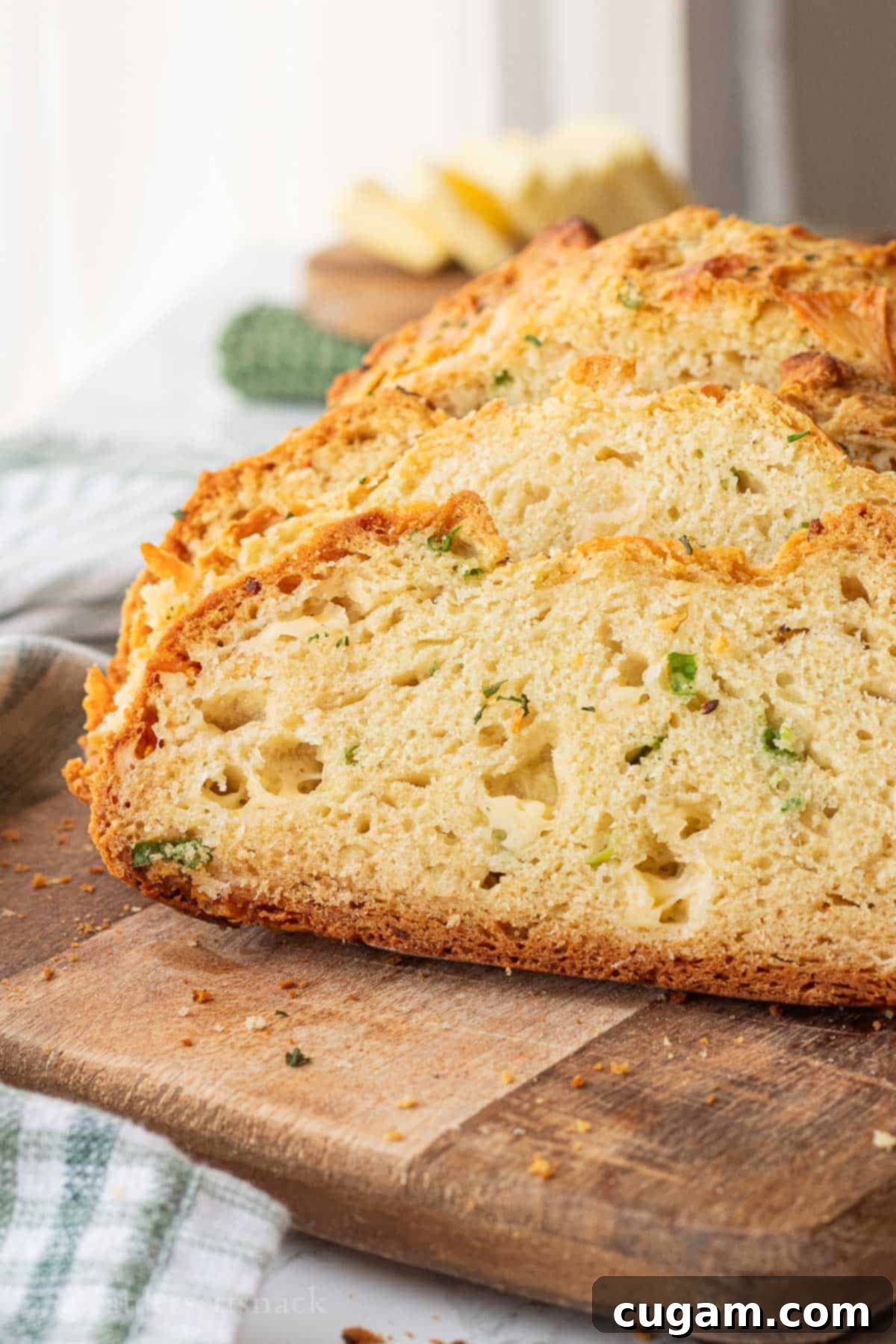
❓Frequently Asked Questions About Irish Cheddar Soda Bread
Absolutely, yes! The key to traditional soda bread’s rise is the chemical reaction between baking soda and an acid. While buttermilk is a common choice, any acid will work. In this recipe, we successfully use a mixture of milk and white vinegar as a fantastic buttermilk substitute. The vinegar acidifies the milk, creating a “homemade buttermilk” that reacts with the baking soda to make the bread light and fluffy. This is especially convenient if you don’t frequently buy or use buttermilk, ensuring you can still enjoy delicious soda bread whenever the craving strikes!
Irish soda bread is incredibly versatile! We love to enjoy this savory version toasted with a generous spread of butter – the warmth truly brings out the flavors of the cheese, garlic, and onion. It’s also an excellent accompaniment to a wide variety of meals, serving as a hearty side dish. Think delicious soups, comforting stews (like beef or vegetable stew), chili, or even alongside a Sunday roast. Its sturdy texture makes it perfect for soaking up rich sauces and gravies, or simply as a satisfying snack on its own.
Yes, warming it up is highly recommended! While Irish soda bread can certainly be enjoyed at room temperature, toasting it or gently reheating it (especially with butter) truly enhances its flavors and texture. Warming the bread makes the cheese melty and gooey again, crisps up the crust, and releases the aromatic notes of garlic and onion. A quick toast in a toaster oven or a few minutes in a warm skillet can transform a simple slice into an indulgent treat.
To keep your Irish cheddar soda bread fresh, store any leftovers at room temperature in an airtight container or tightly wrapped in plastic wrap for up to 3 days. For longer storage, it freezes exceptionally well! Wrap the cooled loaf or individual slices tightly in plastic wrap, then again in aluminum foil, and place in a freezer-safe bag for up to 3 months. Thaw at room temperature and reheat gently for best results.
While the basic method of soda bread is traditional to Ireland, this particular recipe with added cheddar, garlic, and onions is a savory variation. Traditional Irish soda bread typically contains only four ingredients: flour, baking soda, salt, and buttermilk (or a milk/acid substitute). Our recipe takes inspiration from that simplicity but adds popular savory enhancements to create a more flavorful and hearty loaf, perfect for modern tastes and pairings.
🥖 Discover More Easy & Delicious Bread Recipes
If you’ve enjoyed making this savory Irish cheddar soda bread, you’re in for a treat with our other simple and satisfying bread recipes. From quick breads to yeasted delights, we have something for every baking enthusiast.
- Sourdough Discard Cornbread
- Old Fashioned Yeast Rolls
- Sourdough Discard Banana Bread
- Lemon Poppy Seed Zucchini Bread
Did you try this amazing recipe? Your feedback truly makes our day! Make sure to leave a ⭐️ star rating and a thoughtful comment below the recipe card. We absolutely love hearing from you, and your insights are incredibly helpful to other readers looking for delicious meal ideas.
📲 FOLLOW Sara on Social! 👋 Facebook, Instagram, or Pinterest to stay up-to-date with the latest culinary creations and behind-the-scenes glimpses from our kitchen!
📝 Printable Recipe
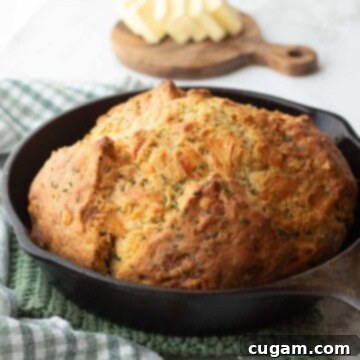
Irish Cheddar Soda Bread
Pin Recipe
Ingredients
- 1 cup milk 240 mL
- 1 teaspoon white vinegar 5 mL
- 1 large egg
- 3¼ cups all purpose flour 455 g
- 1 teaspoon baking soda 8 g
- ¾ teaspoon salt 4 g
- 4 Tablespoons salted butter 56 g
- 2-3 green onion stalks (¼ cup or 30g chopped)
- 4 oz cheddar cheese 115 g
- 2 teaspoons minced garlic 11 g
Instructions
-
Preheat your oven to 375℉ (190°C). Prepare a 9-inch cast iron pan by lightly spraying it with baking spray, or line a large baking sheet with parchment paper. This step ensures easy removal and prevents sticking.
-
In a small bowl or a liquid measuring cup, combine the milk and white vinegar. Stir them together gently and let the mixture sit for 5 minutes. This creates a homemade buttermilk substitute, essential for the recipe’s leavening.
-
Once the milk-vinegar mixture has rested, add the large egg and whisk everything thoroughly until well combined. This wet mixture will provide richness and moisture to the dough.
-
In a separate, large mixing bowl, combine the all-purpose flour, baking soda, and salt. Add the cold, cubed butter to these dry ingredients. Use your hands or a fork to crumble the butter into the flour mixture until it resembles coarse crumbs, with butter pieces roughly the size of small peas. This method contributes to the bread’s tender crumb.
-
Finely mince the green onions and chop the cheddar cheese into small, approximately ¼-inch (0.5 cm) cubes. Uniform pieces will ensure even distribution of flavor and melting.
-
Add the minced green onions, chopped cheddar cheese, and minced garlic (or garlic powder, if substituting, remember to use half the amount) to the flour and butter mixture. Toss gently to distribute these savory additions evenly.
-
Pour the prepared milk and egg mixture into the dry ingredients. Mix with a wooden spoon or your hands until a cohesive dough forms. Be careful not to overmix; just combine until no dry streaks of flour are visible.
-
Transfer the dough to a lightly floured surface. Knead it gently about 10 times, just enough to ensure all ingredients are incorporated and the dough is smooth. Avoid extensive kneading. If the dough is sticky, dust your hands lightly with flour. Gently form the dough into a round ball.
-
Place the dough ball into your prepared cast iron frying pan or onto the lined baking sheet. Using a sharp knife, cut a cross about ¼ inch (0.5 cm) deep into the top of the loaf. This traditional scoring helps the bread bake more evenly and rise beautifully.
-
Bake for 45-55 minutes, or until the loaf is golden brown and an instant-read thermometer inserted into the center registers an internal temperature of 200℉ (93°C). Once baked, remove from the oven and let it cool on a wire rack for at least 30 minutes before slicing. This cooling period is crucial for the bread’s texture to set. Enjoy your delicious, homemade Irish Cheddar Soda Bread!
Notes
If you choose to use garlic powder as a substitute for fresh minced garlic, remember to use half the amount called for in the recipe, as garlic powder is more potent in flavor.
Store any leftover Irish cheddar soda bread at room temperature, tightly wrapped in plastic wrap or in an airtight container, for up to 3 days to maintain its freshness and flavor.
For longer storage, this bread freezes beautifully. Once completely cooled, wrap the entire loaf or individual slices tightly in plastic wrap, then again in aluminum foil, and place in a freezer-safe bag. It can be frozen for up to 3 months. Thaw at room temperature and warm gently before serving.
Nutrition

Hi, I’m Sara!
Registered Nurse by day, food blogger by weekend. Perfect dip tester & snack quester. I love short walks on the beach and long naps. Sharing my love for food, one bite at a time.
